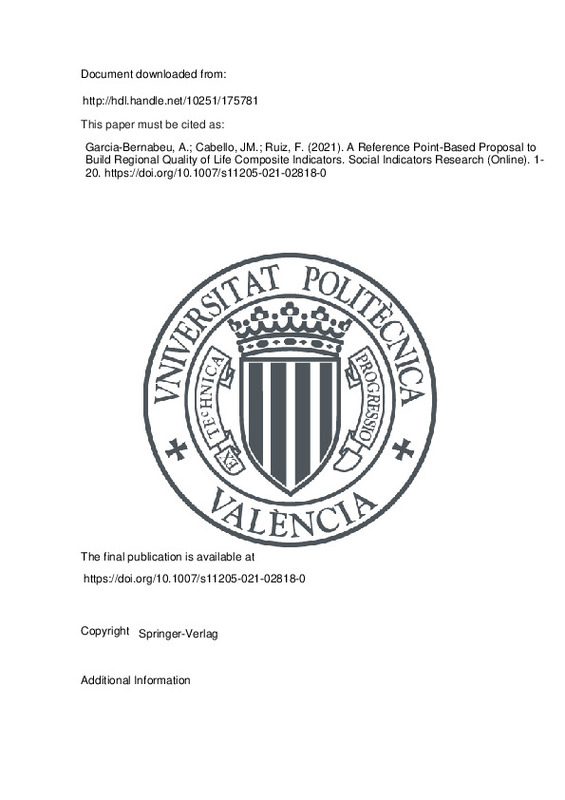Blancas, F., Caballero, R., González, M., Lozano-Oyola, M., & Pérez, F. (2010). Goal programming synthetic indicators: An application for sustainable tourism in andalusian coastal counties. Ecological Economics, 69(11), 2158–2172.
Boggia, A., Massei, G., Pace, E., Rocchi, L., Paolotti, L., & Attard, M. (2018). Spatial multicriteria analysis for sustainability assessment: A new model for decision making. Land Use Policy, 71, 281–292.
Booysen, F. (2002). An overview and evaluation of composite indices of development. Social Indicators Research, 59(2), 115–151.
[+]
Blancas, F., Caballero, R., González, M., Lozano-Oyola, M., & Pérez, F. (2010). Goal programming synthetic indicators: An application for sustainable tourism in andalusian coastal counties. Ecological Economics, 69(11), 2158–2172.
Boggia, A., Massei, G., Pace, E., Rocchi, L., Paolotti, L., & Attard, M. (2018). Spatial multicriteria analysis for sustainability assessment: A new model for decision making. Land Use Policy, 71, 281–292.
Booysen, F. (2002). An overview and evaluation of composite indices of development. Social Indicators Research, 59(2), 115–151.
Cabello, J. M., Ruiz, F., Pérez-Gladish, B., & Méndez-Rodríguez, P. (2014). Synthetic indicators of mutual fund’s environmental responsibility: An application of the Reference Point Method. European Journal of Operational Research, 236(1), 313–325.
Costa, D. S. (2015). Reflective, causal, and composite indicators of quality of life: A conceptual or an empirical distinction? Quality of Life Research, 24(9), 2057–2065.
Durand, M. (2015). The OCDE better life initiative: How’s life? and the measurement of well-being. Review of Income and Wealth, 61(1), 4–17.
El Gibari, S., Cabello, J. M., Gómez, T., & Ruiz, F. (2021). Composite indicators as decision making tools: The joint use of compensatory and non-compensatory schemes. International Journal of Information Technology and Decision Making, 20(3), 847–879.
El Gibari, S., Gómez, T., & Ruiz, F. (2018). Evaluating university performance using reference point based composite indicators. Journal of Informetrics, 12(4), 1235–1250.
El Gibari, S., Gómez, T., & Ruiz, F. (2019). Building composite indicators using multicriteria methods: A review. Journal of Business Economics, 89(1), 1–24.
European Commission: Eurostat quality of life database. (2020). url http://ec.europa.eu/eurostat/data/database.
Freudenberg, M. (2003). Composite indicators of country performance.
Garcia-Bernabeu, A., Cabello, J. M., & Ruiz, F. (2020). A multi-criteria reference point based approach for assessing regional innovation performance in Spain. Mathematics, 8(5), 797.
Goerlich, F. J., & Reig, E. (2021). Quality of life ranking of spanish cities: A non-compensatory approach. Cities, 109, 102979.
Greco, S., Ishizaka, A., Tasiou, M., & Torrisi, G. (2018). On the methodological framework of composite indices: A review of the issues of weighting, aggregation, and robustness. Social Indicators Research, 141, 61–94.
Greyling, T., & Tregenna, F. (2017). Construction and analysis of a composite quality of life index for a region of South Africa. Social Indicators Research, 131(3), 887–930.
Hagerty, M. R., Cummins, R., Ferriss, A. L., Land, K., Michalos, A. C., Peterson, M., et al. (2001). Quality of life indexes for national policy: Review and agenda for research. Bulletin of Sociological Methodology/Bulletin de Méthodologie Sociologique, 71(1), 58–78.
INE: Indicadores de calidad de vida. (2020). url https://cutt.ly/Zj0L0qX.
Ivaldi, E., Bonatti, G., Soliani, R., et al. (2014). Composite index for quality of life in italian cities: An application to urbes indicators. Review of Economics and Finance, 4(4)
Karagiannis, R., & Karagiannis, G. (2020). Constructing composite indicators with shannon entropy: The case of human development index. Socio-Economic Planning Sciences, 70, 100701.
Lagas, P., van Dongen, F., van Rijn, F., & Visser, H. (2015). Regional quality of living in Europe. Region, 2(2), 1–26.
Malkina-Pykh, I. G., & Pykh, Y. A. (2008). Quality-of-life indicators at different scales: Theoretical background. Ecological Indicators, 8(6), 854–862.
Marchante, A. J., & Ortega, B. (2006). Quality of life and economic convergence across Spanish regions, 1980–2001. Regional Studies, 40(5), 471–483.
Mazziotta, M., & Pareto, A. (2016). On a generalized non-compensatory composite index for measuring socio-economic phenomena. Social Indicators Research, 127(3), 983–1003.
Mazziotta, M., & Pareto, A. (2020). Composite indices construction: The performance interval approach. Social Indicators Research pp. 1–11.
Nardo, M., Saisana, M., Saltelli, A., Tarantola, S., Hoffman, A., & Giovannini, E. (2008). Handbook on constructing composite indicators.
OECD: Handbook on constructing composite indicators: methodology and user guide. (2008). Paris: OECD publishing.
Patil, G.R., & Sharma, G. (2020). Urban quality of life: An assessment and ranking for indian cities. Transport Policy.
Royuela, V., Suriñach, J., & Reyes, M. (2003). Measuring quality of life in small areas over different periods of time. Social Indicators Research, 64(1), 51–74.
Ruiz, F., Cabello, J. M., & Luque, M. (2011). An application of reference point techniques to the calculation of synthetic sustainability indicators. Journal of the Operational Research Society, 62(1), 189–197.
Ruiz, F., Cabello, J. M., & Pérez-Gladish, B. (2018). Building ease-of-doing-business synthetic indicators using a double reference point approach. Technological Forecasting and Social Change, 131, 130–140.
Ruiz, F., El Gibari, S., Cabello, J.M., & Gómez, T. (2019). MRP-WSCI: Multiple reference point based weak and strong composite indicators. Omega.
Saisana, M., & Tarantola, S. (2002). State-of-the-art report on current methodologies and practices for composite indicator development. Ispra: Joint Research Centre.
Stiglitz, J.E., Sen, A., Fitoussi, J.P., et al. (2009). Report by the commission on the measurement of economic performance and social progress.
[-]







![[Cerrado]](/themes/UPV/images/candado.png)


